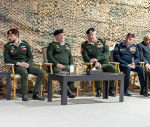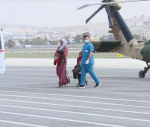You are here
Maan — dangerous or just desperate?
May 04,2017 - Last updated at May 04,2017
The Jordanian city of Maan, 220km south of Amman, has many reasons for being distinctive in its national context.
The city, surrounded by endless hot and dusty vistas, has been described by international media outlets such as The Economist and Al Jazeera as “a hotbed of Daesh”.
According to The Financial Times, Maan can be seen as the Jordanian equivalent of Iraqi cities like Mosul and Tikrit.
Due to government marginalisation and poor economic standards, these two Iraqi cities were seen as particularly susceptible to the influence of radical groups.
It is a damning and dangerous list for Maan to be placed on.
During a recent group discussion, conducted by the WANA Institute and arranged by the Anwar Charitable Association, a sample of residents from Maan stated clearly, perhaps unsurprisingly, that they dislike and reject such a reputation.
Many feel it is a media distortion and an unfair representation of what one described as a “kind and generous city”.
An elderly woman participating in the discussion commented: “They usually say that Maan is a place of radicalisation, but this is not the case, there are men who are unemployed and with nothing to do, they have no opportunities to develop their skills, and so they go to join jihad”.
According to official data, Maan has the highest recorded unemployment rate in the country, averaging nearly 17 per cent, with figures suspected to be more like 30 per cent for people under the age of 25. It is also the poorest governorate in the country, with many living under the poverty line.
The broader economic and social contexts are held centrally responsible by many living in Maan for its purported links to radical groups.
With a strong tribal heritage and history of disagreements with the government, there are clearly dissatisfactions, but it is interesting and necessary to consider whether this translates into support for Daesh.
The Anwar Charity Association suggests that 62 people left Maan to fight in Syria and Iraq between 2012 and 2013.
The association claims, however, that there have been no recruits from Maan in the last year-and-a- half. This could be the result of a growing disgust and disillusionment with Daesh’s extreme tactics, although it may also reflect the unwillingness of authorities to release accurate figures.
The director of the association explained: “There are people who have radical ideas in the city, but do not necessarily create an organised group.”
These radical ideas have manifested in the last few years in small protests in which the Daesh flag has been raised. There have also been cases of pro-Daesh graffiti adorning the barren city walls.
The graffiti, having attracted the attention of the international media, has been repeatedly whitewashed by local authorities.
It is easy to see how small symbols such as flags and graffiti may be leapt upon as indicators of a brooding and growing problem in the city, but in terms of numbers, the amount of people enacting upon them appears minimal.
It is perhaps this difference, between ideological and behavioural radicalisation, which is the crux of the misrepresentation of Maan.
A certain presence of frustrated and somewhat radical thinking is clear, but whether this necessarily includes condoning violent behaviour is much more ambiguous.
Many people in Maan believe that Daesh does not represent a correct interpretation of Islam, and that those persuaded to join are often, although not exclusively, uneducated and misinformed.
Several respondents indicated the practical support Daesh promises to fighters as likely to lure individuals.
A young woman who took part in the discussion said: “They offer to look after their families, they offer them marriage and people are desperate.”
A young man from Maan shared his understanding of Daesh recruitment tactics: “Daesh uses a media approach in which they ask three questions which beg the answer ‘yes’. They ask ‘aren’t you frustrated about what is happening in Syria?’ Yes. ‘Don’t you think the Arab states should be doing something?’ Yes. ‘Have you seen how people are suffering?’ Yes. Daesh then responds: ‘Well these are the people responsible, you should attack them’.”
Once again, the manipulated pressure points focus on current affairs and political elements opposed to religious doctrine.
One of the latest Daesh-produced videos, released in early April, featured the brutal beheadings of four Syrians who had been trained by Americans in conjunction with the Jordanian army.
In the video, Daesh specifically attempts to reach out to members of different tribes to join its cause.
It is this sort of propaganda that could affect disenfranchised governorates with a strong tribal heritage, such as Maan.
With its geographic proximity to the West Bank, Saudi Arabia and Syria, Jordan is seen by many, Daesh included, as a crucial interlocutor in the region.
It is a position that gives it a political weight in the global sphere, one that is perhaps at odds with its economic power.
It is evident that Maan is susceptible to external forces and harbours many deep-seated frustrations, but to automatically associate these with radical influences would be, according to residents, a mistake.
Instead, it is abundantly clear that Maan needs support in the form of human security measures.
Most vitally, an outlet is desperately required for the young and frustrated.
Activities, employment opportunities, a political voice and daily purpose: for many in Maan, none of these currently seem available.
If Daesh is indeed successful in creating sympathisers and potential recruits in Maan, it may be because the group provides opportunities in an environment where other options remain elusive.
The writer is a researcher at the WANA Institute specialising in human security and countering violent extremism. She contributed this article to The Jordan Times.












